Employee Retention and Reward Systems
VerifiedAdded on 2020/05/28
|15
|3843
|531
AI Summary
This assignment delves into the impact of employee reward systems on retention. It examines research articles that explore the relationship between compensation packages, job satisfaction, and organizational commitment as factors influencing employee loyalty. The analysis focuses on identifying effective strategies for employers to retain employees through a well-designed reward system.
Contribute Materials
Your contribution can guide someone’s learning journey. Share your
documents today.
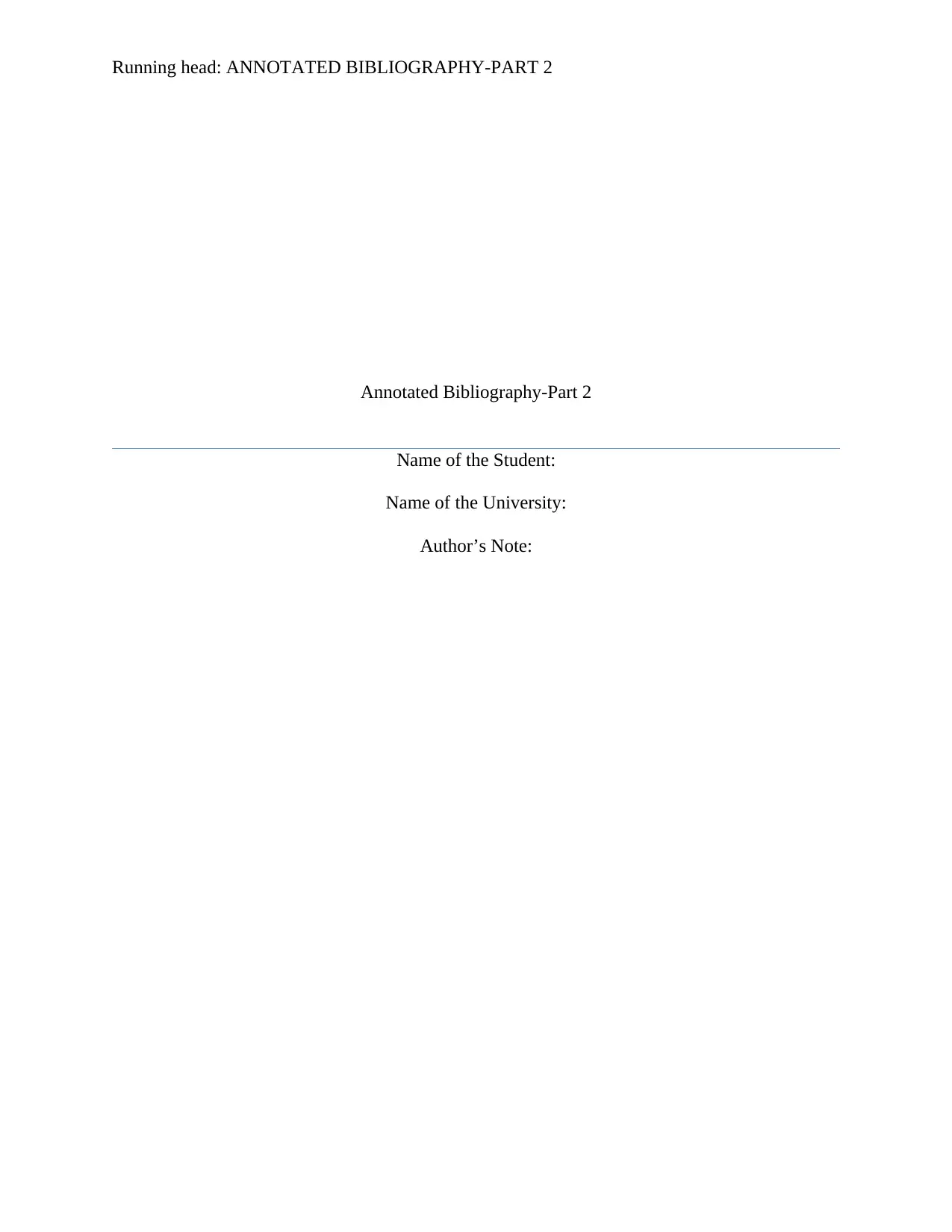
Running head: ANNOTATED BIBLIOGRAPHY-PART 2
Annotated Bibliography-Part 2
Name of the Student:
Name of the University:
Author’s Note:
Annotated Bibliography-Part 2
Name of the Student:
Name of the University:
Author’s Note:
Secure Best Marks with AI Grader
Need help grading? Try our AI Grader for instant feedback on your assignments.
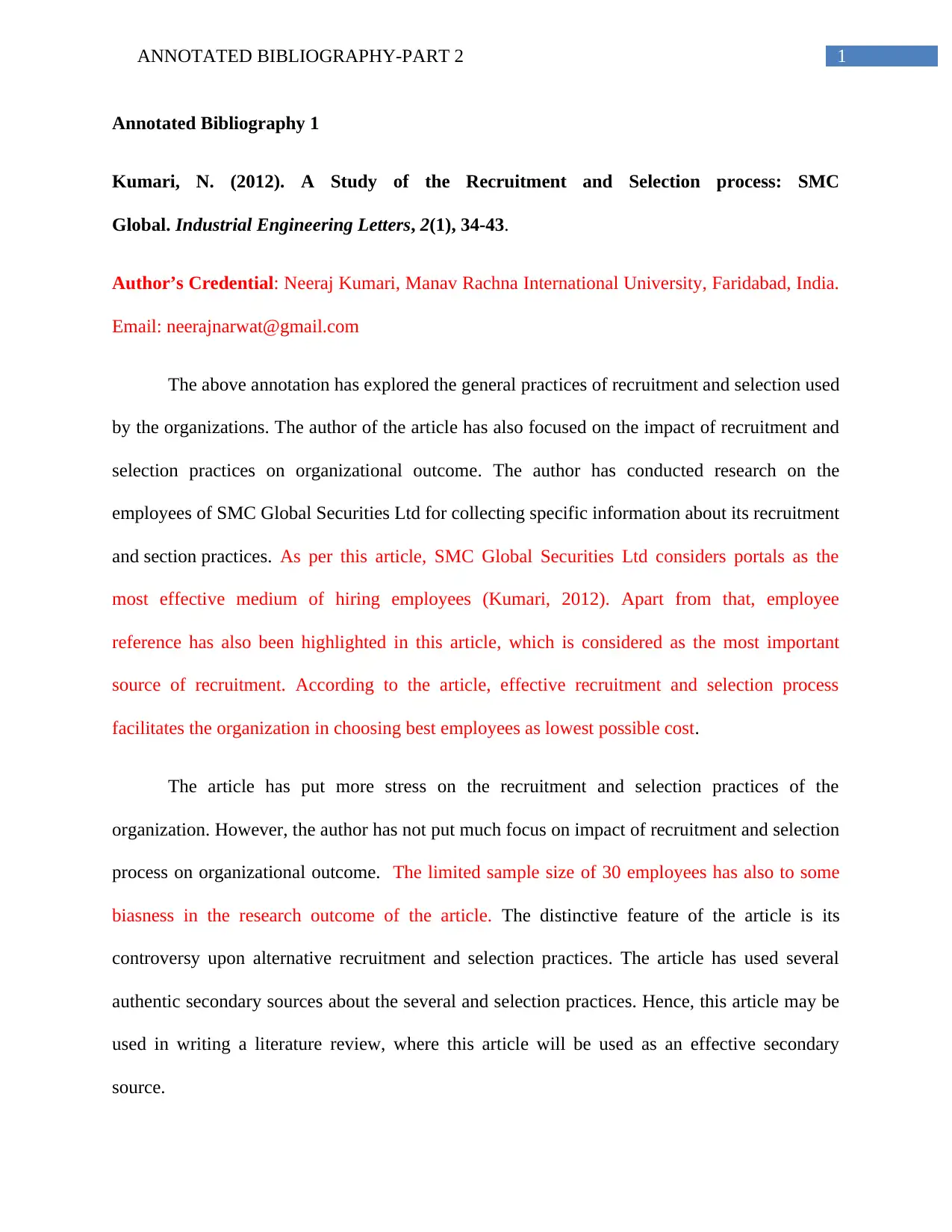
1ANNOTATED BIBLIOGRAPHY-PART 2
Annotated Bibliography 1
Kumari, N. (2012). A Study of the Recruitment and Selection process: SMC
Global. Industrial Engineering Letters, 2(1), 34-43.
Author’s Credential: Neeraj Kumari, Manav Rachna International University, Faridabad, India.
Email: neerajnarwat@gmail.com
The above annotation has explored the general practices of recruitment and selection used
by the organizations. The author of the article has also focused on the impact of recruitment and
selection practices on organizational outcome. The author has conducted research on the
employees of SMC Global Securities Ltd for collecting specific information about its recruitment
and section practices. As per this article, SMC Global Securities Ltd considers portals as the
most effective medium of hiring employees (Kumari, 2012). Apart from that, employee
reference has also been highlighted in this article, which is considered as the most important
source of recruitment. According to the article, effective recruitment and selection process
facilitates the organization in choosing best employees as lowest possible cost.
The article has put more stress on the recruitment and selection practices of the
organization. However, the author has not put much focus on impact of recruitment and selection
process on organizational outcome. The limited sample size of 30 employees has also to some
biasness in the research outcome of the article. The distinctive feature of the article is its
controversy upon alternative recruitment and selection practices. The article has used several
authentic secondary sources about the several and selection practices. Hence, this article may be
used in writing a literature review, where this article will be used as an effective secondary
source.
Annotated Bibliography 1
Kumari, N. (2012). A Study of the Recruitment and Selection process: SMC
Global. Industrial Engineering Letters, 2(1), 34-43.
Author’s Credential: Neeraj Kumari, Manav Rachna International University, Faridabad, India.
Email: neerajnarwat@gmail.com
The above annotation has explored the general practices of recruitment and selection used
by the organizations. The author of the article has also focused on the impact of recruitment and
selection practices on organizational outcome. The author has conducted research on the
employees of SMC Global Securities Ltd for collecting specific information about its recruitment
and section practices. As per this article, SMC Global Securities Ltd considers portals as the
most effective medium of hiring employees (Kumari, 2012). Apart from that, employee
reference has also been highlighted in this article, which is considered as the most important
source of recruitment. According to the article, effective recruitment and selection process
facilitates the organization in choosing best employees as lowest possible cost.
The article has put more stress on the recruitment and selection practices of the
organization. However, the author has not put much focus on impact of recruitment and selection
process on organizational outcome. The limited sample size of 30 employees has also to some
biasness in the research outcome of the article. The distinctive feature of the article is its
controversy upon alternative recruitment and selection practices. The article has used several
authentic secondary sources about the several and selection practices. Hence, this article may be
used in writing a literature review, where this article will be used as an effective secondary
source.

2ANNOTATED BIBLIOGRAPHY-PART 2
Annotated Bibliography 2
Nabi, G., Wei, S., Husheng, X., Shabbir, M., Altaf, M., & Zhao, S. (2014). Effective
Recruitment and Selection Procedures: an Analytical Study Based on Public Sector
Universities of Pakistan. Public Policy and Administration Research, 4(10), 12-20.
Author’s Credential: Ghulam Nabi (Corresponding Author), School of Public Affairs,
University of Science & Technology China,Hefei, Anhui (230026)P.R C. E-mail:
ghulam@mail.ustc.edu.cn
Song Wei, PhD, Professor & Dean, School of Public Affairs,University of Science &
Technology China.
Xu Husheng Muhammad Shabbir Muhammad Altaf Shuliang Zhao, School of Public Affairs,
University of Science & Technology China
The above mentioned annotation is strongly focused on the effectiveness of the fair
recruitment and selection procedures on organization. Unlike the previous studies, this article has
focused on the ways of bringing effectiveness in the fairness of recruitment and selection
process. The author of this article has majorly focused on the organizational politics, which has
high level of negative impact on the fairness of recruitment and selection process. The article has
revealed that organizational politics hamper the recruitment and selection effectiveness and lead
to poor coordination between staff and line authority. The authors have specifically collected
information regarding recruitment and selection from the public sector universities of Azad
Jammu & Kashmir and Pakistan. The article has also pointed out the critic that line mangers
have huge influence on the human resource specialists in regards to recruitment and selection
process (Nabi et al., 2014). However, 80 sample respondents are quite less for proving the
Annotated Bibliography 2
Nabi, G., Wei, S., Husheng, X., Shabbir, M., Altaf, M., & Zhao, S. (2014). Effective
Recruitment and Selection Procedures: an Analytical Study Based on Public Sector
Universities of Pakistan. Public Policy and Administration Research, 4(10), 12-20.
Author’s Credential: Ghulam Nabi (Corresponding Author), School of Public Affairs,
University of Science & Technology China,Hefei, Anhui (230026)P.R C. E-mail:
ghulam@mail.ustc.edu.cn
Song Wei, PhD, Professor & Dean, School of Public Affairs,University of Science &
Technology China.
Xu Husheng Muhammad Shabbir Muhammad Altaf Shuliang Zhao, School of Public Affairs,
University of Science & Technology China
The above mentioned annotation is strongly focused on the effectiveness of the fair
recruitment and selection procedures on organization. Unlike the previous studies, this article has
focused on the ways of bringing effectiveness in the fairness of recruitment and selection
process. The author of this article has majorly focused on the organizational politics, which has
high level of negative impact on the fairness of recruitment and selection process. The article has
revealed that organizational politics hamper the recruitment and selection effectiveness and lead
to poor coordination between staff and line authority. The authors have specifically collected
information regarding recruitment and selection from the public sector universities of Azad
Jammu & Kashmir and Pakistan. The article has also pointed out the critic that line mangers
have huge influence on the human resource specialists in regards to recruitment and selection
process (Nabi et al., 2014). However, 80 sample respondents are quite less for proving the

3ANNOTATED BIBLIOGRAPHY-PART 2
authenticity of the collected information. The distinctive feature of this article is collection
authentic secondary information regarding the recruitment and selection fairness of large size
organizations. Such information can be effectively used in writing literature review.
Annotated Bibliography 3
Visa, A., Einolander, J., & Vanharanta, H. (2015). New Tools to Help in the Recruitment
Process. Procedia Manufacturing, 3, 653-659.
Author’s Credential: Ari Visaa, Jarno Einolander, Hannu Vanharanta, Tampere University Of
Technology, Department of Signal Processing, Korkeakoulunkatu 1, Tampere, FI-33101, Finland
Tampere University of Technology, Department of Industrial Management and Engineering,
Pohjoisranta 11 A, 28100, Pori, Finland
This annotation has been focused on best tools to help the recruitment process of
organizations. This article has revealed that interview and various types of psychological tests
are quite expensive for the recruitment and selection process of the organizations. The authors of
this article have introduced new approach Evolute Helix for flexible and effective recruitment
and selection process. However, the article has also argued over the fact that automated process
is not much effective for selection process, as this process requires some human analysis for
choosing the right candidate for right position. The authors have revealed that Helix approach
provide authentic information about the candidates, which can facilitate the organizations both
their recruitment as well as selection process (Visa et al., 2015). The article may seem to be
somewhat ineffective to prove the effectiveness of new recruitment and selection tool, as it has
been applied on only 55 candidates. The distinctive feature of the article relies on the fact that it
has initiated effective automated tool for effective recruitment and selection process. However,
authenticity of the collected information. The distinctive feature of this article is collection
authentic secondary information regarding the recruitment and selection fairness of large size
organizations. Such information can be effectively used in writing literature review.
Annotated Bibliography 3
Visa, A., Einolander, J., & Vanharanta, H. (2015). New Tools to Help in the Recruitment
Process. Procedia Manufacturing, 3, 653-659.
Author’s Credential: Ari Visaa, Jarno Einolander, Hannu Vanharanta, Tampere University Of
Technology, Department of Signal Processing, Korkeakoulunkatu 1, Tampere, FI-33101, Finland
Tampere University of Technology, Department of Industrial Management and Engineering,
Pohjoisranta 11 A, 28100, Pori, Finland
This annotation has been focused on best tools to help the recruitment process of
organizations. This article has revealed that interview and various types of psychological tests
are quite expensive for the recruitment and selection process of the organizations. The authors of
this article have introduced new approach Evolute Helix for flexible and effective recruitment
and selection process. However, the article has also argued over the fact that automated process
is not much effective for selection process, as this process requires some human analysis for
choosing the right candidate for right position. The authors have revealed that Helix approach
provide authentic information about the candidates, which can facilitate the organizations both
their recruitment as well as selection process (Visa et al., 2015). The article may seem to be
somewhat ineffective to prove the effectiveness of new recruitment and selection tool, as it has
been applied on only 55 candidates. The distinctive feature of the article relies on the fact that it
has initiated effective automated tool for effective recruitment and selection process. However,
Secure Best Marks with AI Grader
Need help grading? Try our AI Grader for instant feedback on your assignments.
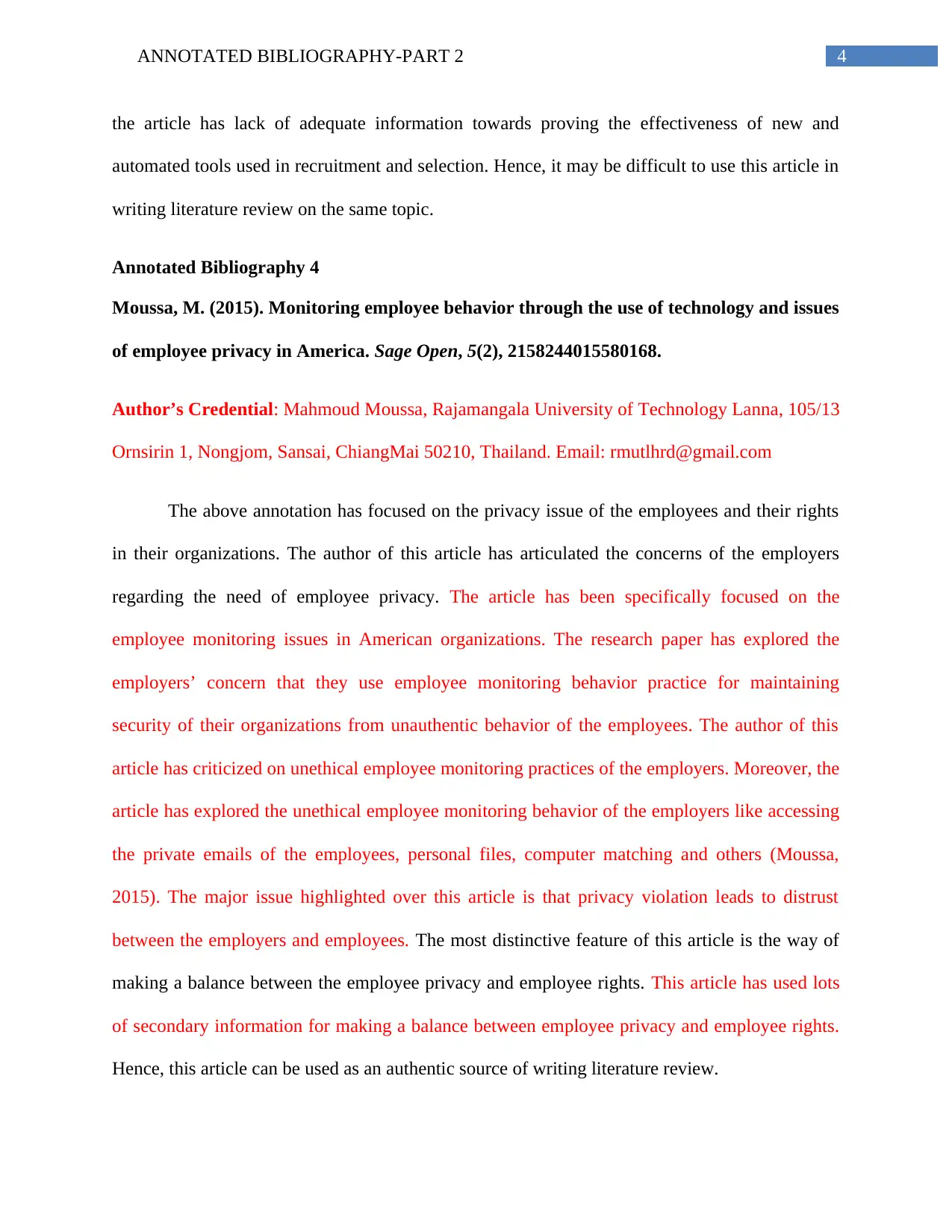
4ANNOTATED BIBLIOGRAPHY-PART 2
the article has lack of adequate information towards proving the effectiveness of new and
automated tools used in recruitment and selection. Hence, it may be difficult to use this article in
writing literature review on the same topic.
Annotated Bibliography 4
Moussa, M. (2015). Monitoring employee behavior through the use of technology and issues
of employee privacy in America. Sage Open, 5(2), 2158244015580168.
Author’s Credential: Mahmoud Moussa, Rajamangala University of Technology Lanna, 105/13
Ornsirin 1, Nongjom, Sansai, ChiangMai 50210, Thailand. Email: rmutlhrd@gmail.com
The above annotation has focused on the privacy issue of the employees and their rights
in their organizations. The author of this article has articulated the concerns of the employers
regarding the need of employee privacy. The article has been specifically focused on the
employee monitoring issues in American organizations. The research paper has explored the
employers’ concern that they use employee monitoring behavior practice for maintaining
security of their organizations from unauthentic behavior of the employees. The author of this
article has criticized on unethical employee monitoring practices of the employers. Moreover, the
article has explored the unethical employee monitoring behavior of the employers like accessing
the private emails of the employees, personal files, computer matching and others (Moussa,
2015). The major issue highlighted over this article is that privacy violation leads to distrust
between the employers and employees. The most distinctive feature of this article is the way of
making a balance between the employee privacy and employee rights. This article has used lots
of secondary information for making a balance between employee privacy and employee rights.
Hence, this article can be used as an authentic source of writing literature review.
the article has lack of adequate information towards proving the effectiveness of new and
automated tools used in recruitment and selection. Hence, it may be difficult to use this article in
writing literature review on the same topic.
Annotated Bibliography 4
Moussa, M. (2015). Monitoring employee behavior through the use of technology and issues
of employee privacy in America. Sage Open, 5(2), 2158244015580168.
Author’s Credential: Mahmoud Moussa, Rajamangala University of Technology Lanna, 105/13
Ornsirin 1, Nongjom, Sansai, ChiangMai 50210, Thailand. Email: rmutlhrd@gmail.com
The above annotation has focused on the privacy issue of the employees and their rights
in their organizations. The author of this article has articulated the concerns of the employers
regarding the need of employee privacy. The article has been specifically focused on the
employee monitoring issues in American organizations. The research paper has explored the
employers’ concern that they use employee monitoring behavior practice for maintaining
security of their organizations from unauthentic behavior of the employees. The author of this
article has criticized on unethical employee monitoring practices of the employers. Moreover, the
article has explored the unethical employee monitoring behavior of the employers like accessing
the private emails of the employees, personal files, computer matching and others (Moussa,
2015). The major issue highlighted over this article is that privacy violation leads to distrust
between the employers and employees. The most distinctive feature of this article is the way of
making a balance between the employee privacy and employee rights. This article has used lots
of secondary information for making a balance between employee privacy and employee rights.
Hence, this article can be used as an authentic source of writing literature review.

5ANNOTATED BIBLIOGRAPHY-PART 2
Annotated Bibliography 5
Yerby, J. (2013). Legal and ethical issues of employee monitoring. Online Journal of
Applied Knowledge Management, 1(2), 44-55.
Johnathan Yerby is affiliated to Middle Georgia State College. This annotation has
illuminated on the legal and ethical issues of employee monitoring. The author of the article has
perfectly aligned the balance between the employee monitoring and employee rights in their
workplaces. As per this article, employee monitoring activities are intended to keep surveillance
on the employees for tracking their misuse of organizational assets. It is extremely necessary for
protecting the organizational security. However, at the same time, the article has also argued on
the rights of the employees to protect their personal information from the employers. The
employers have no right access the online activities of the employees. Such unethical employee
monitoring activities leads to illegality of the employee monitoring system (Yerby, 2013). Over
the years, several articles have put their focus on need for employee privacy, but there was a lack
of focus on the need for employee rights. This article has perfectly described the needs of
balance between employee monitoring behavior and employee rights. It is the most distinctive
feature of the article. However, the secondary information collected for the article is inadequate
for getting authentic information. Furthermore, the article has effectively mentioned some proper
employee monitoring software and rules for protecting employee rights. Hence, such article can
be perfectly used to write literature review on same topic.
Annotated Bibliography 5
Yerby, J. (2013). Legal and ethical issues of employee monitoring. Online Journal of
Applied Knowledge Management, 1(2), 44-55.
Johnathan Yerby is affiliated to Middle Georgia State College. This annotation has
illuminated on the legal and ethical issues of employee monitoring. The author of the article has
perfectly aligned the balance between the employee monitoring and employee rights in their
workplaces. As per this article, employee monitoring activities are intended to keep surveillance
on the employees for tracking their misuse of organizational assets. It is extremely necessary for
protecting the organizational security. However, at the same time, the article has also argued on
the rights of the employees to protect their personal information from the employers. The
employers have no right access the online activities of the employees. Such unethical employee
monitoring activities leads to illegality of the employee monitoring system (Yerby, 2013). Over
the years, several articles have put their focus on need for employee privacy, but there was a lack
of focus on the need for employee rights. This article has perfectly described the needs of
balance between employee monitoring behavior and employee rights. It is the most distinctive
feature of the article. However, the secondary information collected for the article is inadequate
for getting authentic information. Furthermore, the article has effectively mentioned some proper
employee monitoring software and rules for protecting employee rights. Hence, such article can
be perfectly used to write literature review on same topic.
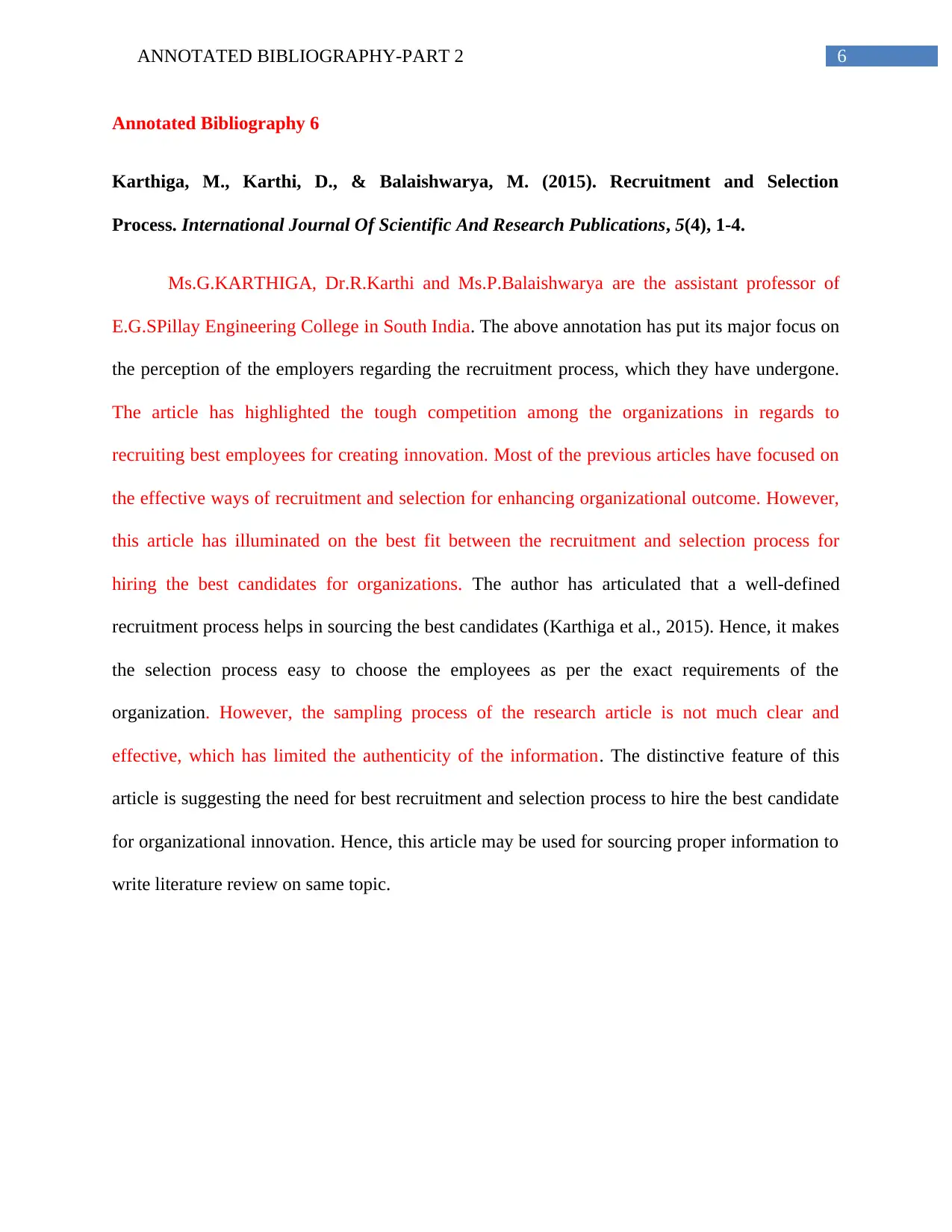
6ANNOTATED BIBLIOGRAPHY-PART 2
Annotated Bibliography 6
Karthiga, M., Karthi, D., & Balaishwarya, M. (2015). Recruitment and Selection
Process. International Journal Of Scientific And Research Publications, 5(4), 1-4.
Ms.G.KARTHIGA, Dr.R.Karthi and Ms.P.Balaishwarya are the assistant professor of
E.G.SPillay Engineering College in South India. The above annotation has put its major focus on
the perception of the employers regarding the recruitment process, which they have undergone.
The article has highlighted the tough competition among the organizations in regards to
recruiting best employees for creating innovation. Most of the previous articles have focused on
the effective ways of recruitment and selection for enhancing organizational outcome. However,
this article has illuminated on the best fit between the recruitment and selection process for
hiring the best candidates for organizations. The author has articulated that a well-defined
recruitment process helps in sourcing the best candidates (Karthiga et al., 2015). Hence, it makes
the selection process easy to choose the employees as per the exact requirements of the
organization. However, the sampling process of the research article is not much clear and
effective, which has limited the authenticity of the information. The distinctive feature of this
article is suggesting the need for best recruitment and selection process to hire the best candidate
for organizational innovation. Hence, this article may be used for sourcing proper information to
write literature review on same topic.
Annotated Bibliography 6
Karthiga, M., Karthi, D., & Balaishwarya, M. (2015). Recruitment and Selection
Process. International Journal Of Scientific And Research Publications, 5(4), 1-4.
Ms.G.KARTHIGA, Dr.R.Karthi and Ms.P.Balaishwarya are the assistant professor of
E.G.SPillay Engineering College in South India. The above annotation has put its major focus on
the perception of the employers regarding the recruitment process, which they have undergone.
The article has highlighted the tough competition among the organizations in regards to
recruiting best employees for creating innovation. Most of the previous articles have focused on
the effective ways of recruitment and selection for enhancing organizational outcome. However,
this article has illuminated on the best fit between the recruitment and selection process for
hiring the best candidates for organizations. The author has articulated that a well-defined
recruitment process helps in sourcing the best candidates (Karthiga et al., 2015). Hence, it makes
the selection process easy to choose the employees as per the exact requirements of the
organization. However, the sampling process of the research article is not much clear and
effective, which has limited the authenticity of the information. The distinctive feature of this
article is suggesting the need for best recruitment and selection process to hire the best candidate
for organizational innovation. Hence, this article may be used for sourcing proper information to
write literature review on same topic.
Paraphrase This Document
Need a fresh take? Get an instant paraphrase of this document with our AI Paraphraser
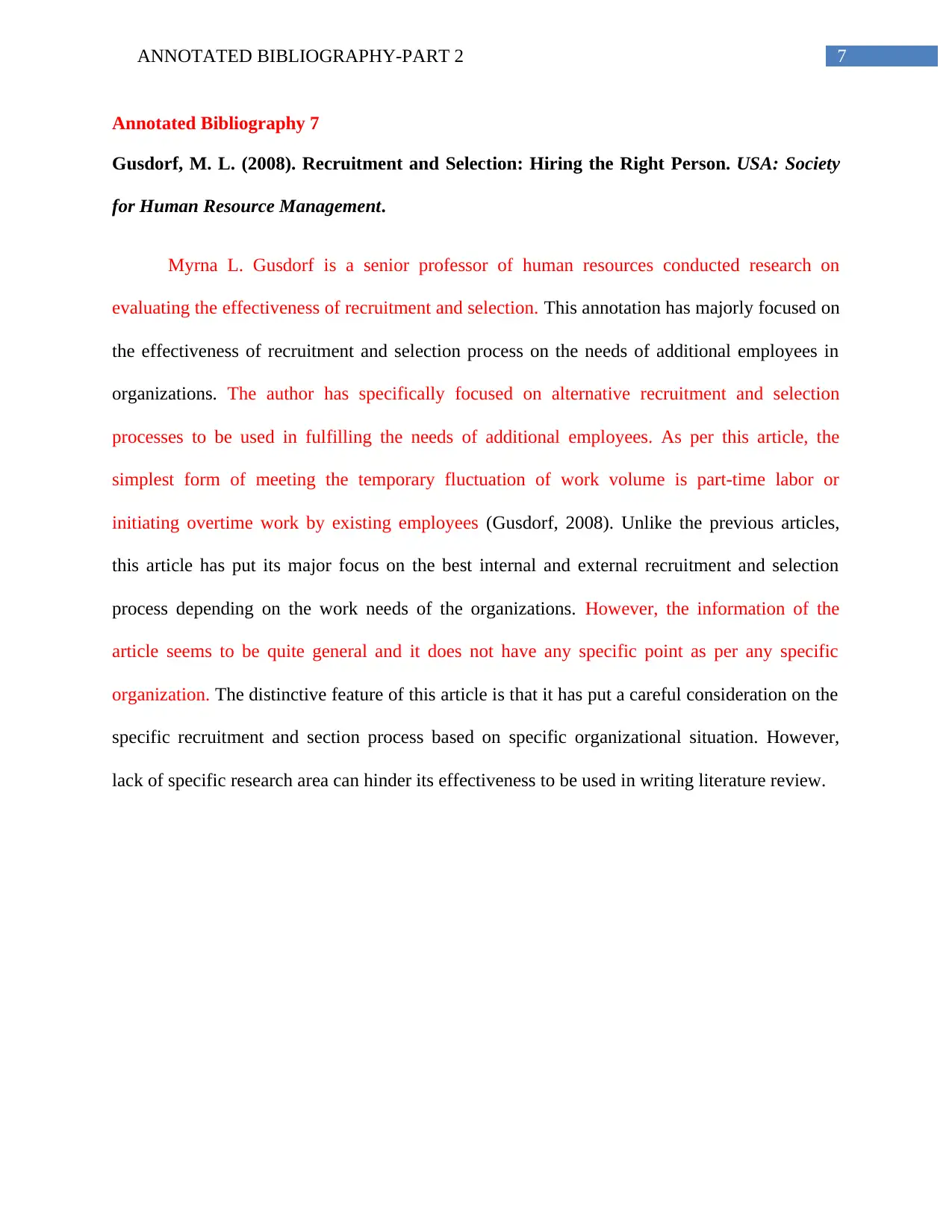
7ANNOTATED BIBLIOGRAPHY-PART 2
Annotated Bibliography 7
Gusdorf, M. L. (2008). Recruitment and Selection: Hiring the Right Person. USA: Society
for Human Resource Management.
Myrna L. Gusdorf is a senior professor of human resources conducted research on
evaluating the effectiveness of recruitment and selection. This annotation has majorly focused on
the effectiveness of recruitment and selection process on the needs of additional employees in
organizations. The author has specifically focused on alternative recruitment and selection
processes to be used in fulfilling the needs of additional employees. As per this article, the
simplest form of meeting the temporary fluctuation of work volume is part-time labor or
initiating overtime work by existing employees (Gusdorf, 2008). Unlike the previous articles,
this article has put its major focus on the best internal and external recruitment and selection
process depending on the work needs of the organizations. However, the information of the
article seems to be quite general and it does not have any specific point as per any specific
organization. The distinctive feature of this article is that it has put a careful consideration on the
specific recruitment and section process based on specific organizational situation. However,
lack of specific research area can hinder its effectiveness to be used in writing literature review.
Annotated Bibliography 7
Gusdorf, M. L. (2008). Recruitment and Selection: Hiring the Right Person. USA: Society
for Human Resource Management.
Myrna L. Gusdorf is a senior professor of human resources conducted research on
evaluating the effectiveness of recruitment and selection. This annotation has majorly focused on
the effectiveness of recruitment and selection process on the needs of additional employees in
organizations. The author has specifically focused on alternative recruitment and selection
processes to be used in fulfilling the needs of additional employees. As per this article, the
simplest form of meeting the temporary fluctuation of work volume is part-time labor or
initiating overtime work by existing employees (Gusdorf, 2008). Unlike the previous articles,
this article has put its major focus on the best internal and external recruitment and selection
process depending on the work needs of the organizations. However, the information of the
article seems to be quite general and it does not have any specific point as per any specific
organization. The distinctive feature of this article is that it has put a careful consideration on the
specific recruitment and section process based on specific organizational situation. However,
lack of specific research area can hinder its effectiveness to be used in writing literature review.
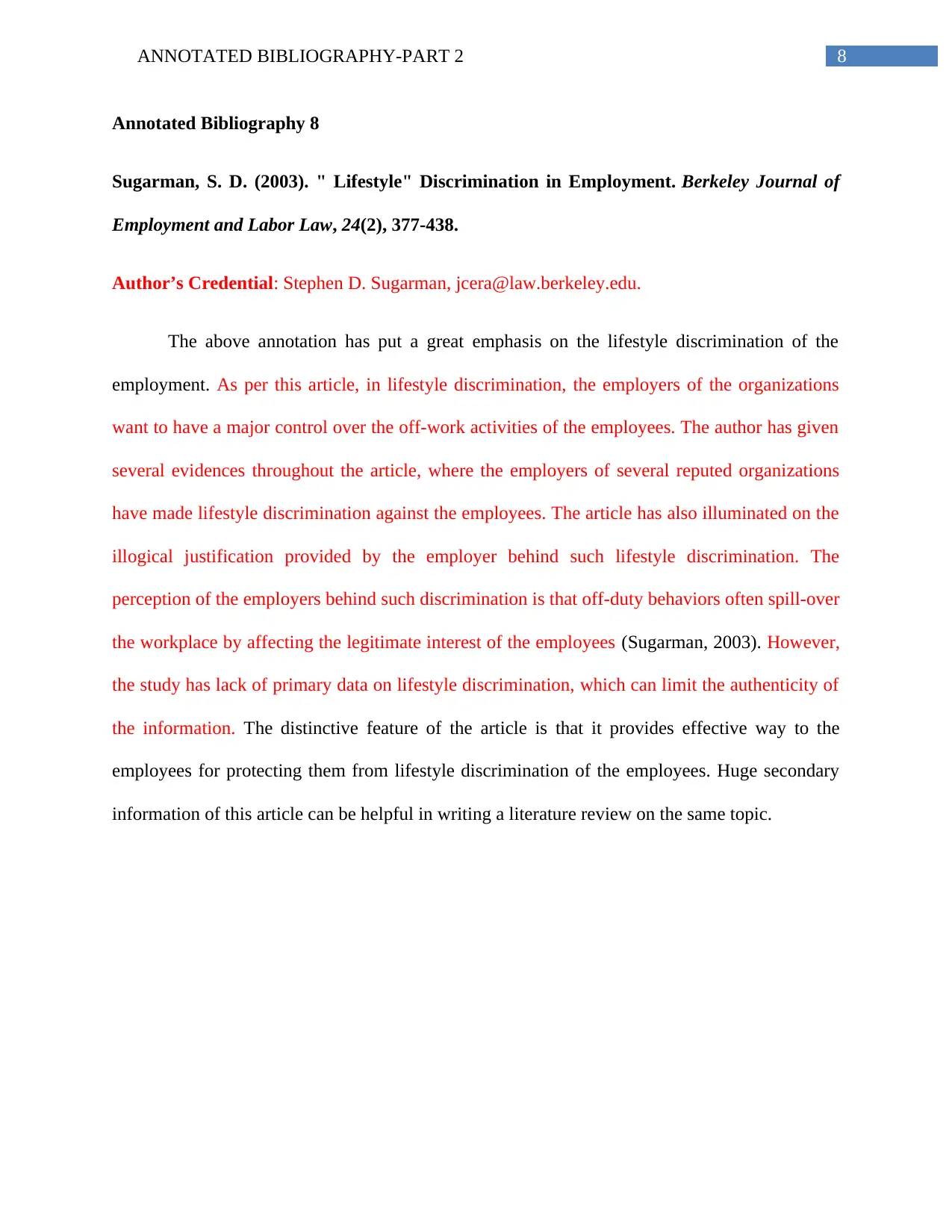
8ANNOTATED BIBLIOGRAPHY-PART 2
Annotated Bibliography 8
Sugarman, S. D. (2003). " Lifestyle" Discrimination in Employment. Berkeley Journal of
Employment and Labor Law, 24(2), 377-438.
Author’s Credential: Stephen D. Sugarman, jcera@law.berkeley.edu.
The above annotation has put a great emphasis on the lifestyle discrimination of the
employment. As per this article, in lifestyle discrimination, the employers of the organizations
want to have a major control over the off-work activities of the employees. The author has given
several evidences throughout the article, where the employers of several reputed organizations
have made lifestyle discrimination against the employees. The article has also illuminated on the
illogical justification provided by the employer behind such lifestyle discrimination. The
perception of the employers behind such discrimination is that off-duty behaviors often spill-over
the workplace by affecting the legitimate interest of the employees (Sugarman, 2003). However,
the study has lack of primary data on lifestyle discrimination, which can limit the authenticity of
the information. The distinctive feature of the article is that it provides effective way to the
employees for protecting them from lifestyle discrimination of the employees. Huge secondary
information of this article can be helpful in writing a literature review on the same topic.
Annotated Bibliography 8
Sugarman, S. D. (2003). " Lifestyle" Discrimination in Employment. Berkeley Journal of
Employment and Labor Law, 24(2), 377-438.
Author’s Credential: Stephen D. Sugarman, jcera@law.berkeley.edu.
The above annotation has put a great emphasis on the lifestyle discrimination of the
employment. As per this article, in lifestyle discrimination, the employers of the organizations
want to have a major control over the off-work activities of the employees. The author has given
several evidences throughout the article, where the employers of several reputed organizations
have made lifestyle discrimination against the employees. The article has also illuminated on the
illogical justification provided by the employer behind such lifestyle discrimination. The
perception of the employers behind such discrimination is that off-duty behaviors often spill-over
the workplace by affecting the legitimate interest of the employees (Sugarman, 2003). However,
the study has lack of primary data on lifestyle discrimination, which can limit the authenticity of
the information. The distinctive feature of the article is that it provides effective way to the
employees for protecting them from lifestyle discrimination of the employees. Huge secondary
information of this article can be helpful in writing a literature review on the same topic.
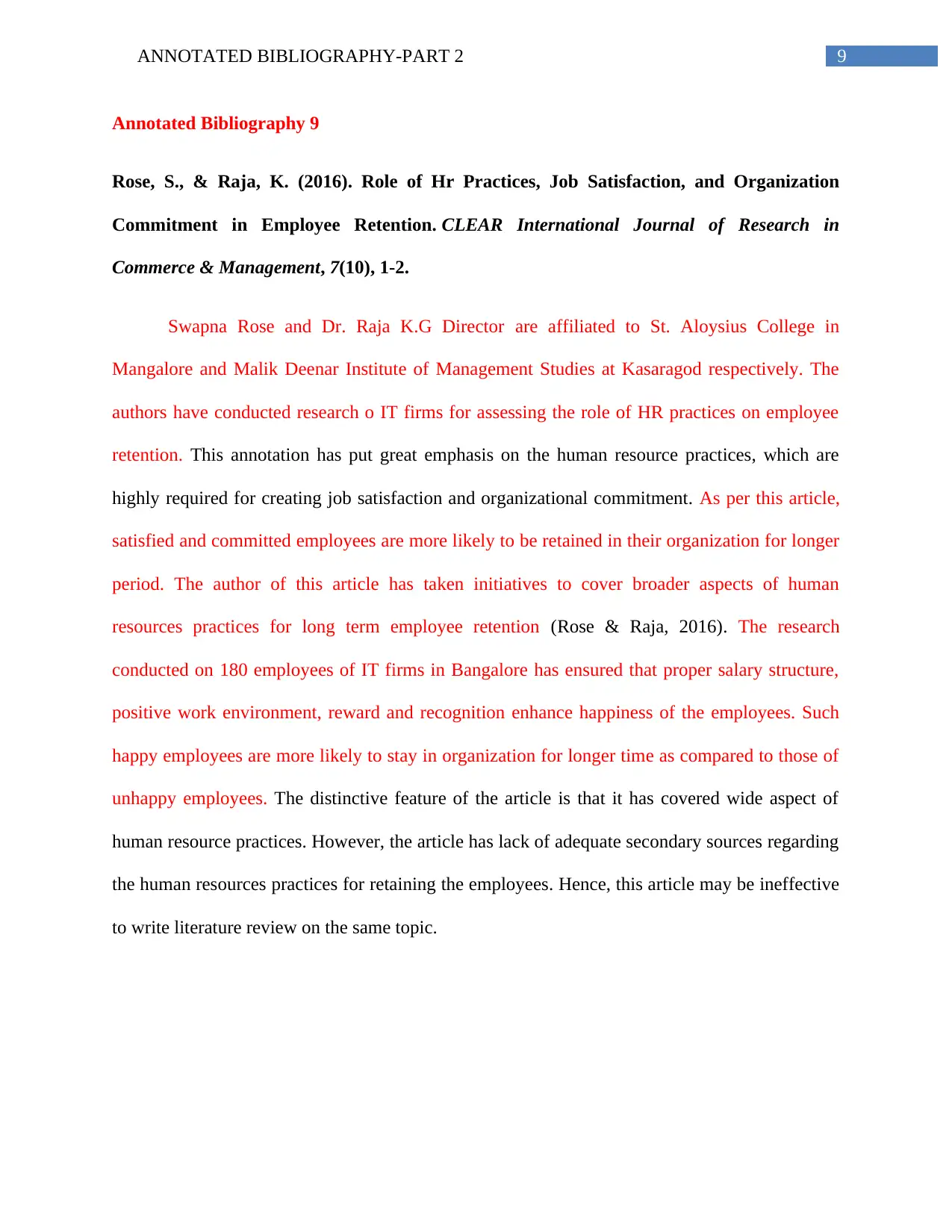
9ANNOTATED BIBLIOGRAPHY-PART 2
Annotated Bibliography 9
Rose, S., & Raja, K. (2016). Role of Hr Practices, Job Satisfaction, and Organization
Commitment in Employee Retention. CLEAR International Journal of Research in
Commerce & Management, 7(10), 1-2.
Swapna Rose and Dr. Raja K.G Director are affiliated to St. Aloysius College in
Mangalore and Malik Deenar Institute of Management Studies at Kasaragod respectively. The
authors have conducted research o IT firms for assessing the role of HR practices on employee
retention. This annotation has put great emphasis on the human resource practices, which are
highly required for creating job satisfaction and organizational commitment. As per this article,
satisfied and committed employees are more likely to be retained in their organization for longer
period. The author of this article has taken initiatives to cover broader aspects of human
resources practices for long term employee retention (Rose & Raja, 2016). The research
conducted on 180 employees of IT firms in Bangalore has ensured that proper salary structure,
positive work environment, reward and recognition enhance happiness of the employees. Such
happy employees are more likely to stay in organization for longer time as compared to those of
unhappy employees. The distinctive feature of the article is that it has covered wide aspect of
human resource practices. However, the article has lack of adequate secondary sources regarding
the human resources practices for retaining the employees. Hence, this article may be ineffective
to write literature review on the same topic.
Annotated Bibliography 9
Rose, S., & Raja, K. (2016). Role of Hr Practices, Job Satisfaction, and Organization
Commitment in Employee Retention. CLEAR International Journal of Research in
Commerce & Management, 7(10), 1-2.
Swapna Rose and Dr. Raja K.G Director are affiliated to St. Aloysius College in
Mangalore and Malik Deenar Institute of Management Studies at Kasaragod respectively. The
authors have conducted research o IT firms for assessing the role of HR practices on employee
retention. This annotation has put great emphasis on the human resource practices, which are
highly required for creating job satisfaction and organizational commitment. As per this article,
satisfied and committed employees are more likely to be retained in their organization for longer
period. The author of this article has taken initiatives to cover broader aspects of human
resources practices for long term employee retention (Rose & Raja, 2016). The research
conducted on 180 employees of IT firms in Bangalore has ensured that proper salary structure,
positive work environment, reward and recognition enhance happiness of the employees. Such
happy employees are more likely to stay in organization for longer time as compared to those of
unhappy employees. The distinctive feature of the article is that it has covered wide aspect of
human resource practices. However, the article has lack of adequate secondary sources regarding
the human resources practices for retaining the employees. Hence, this article may be ineffective
to write literature review on the same topic.
Secure Best Marks with AI Grader
Need help grading? Try our AI Grader for instant feedback on your assignments.
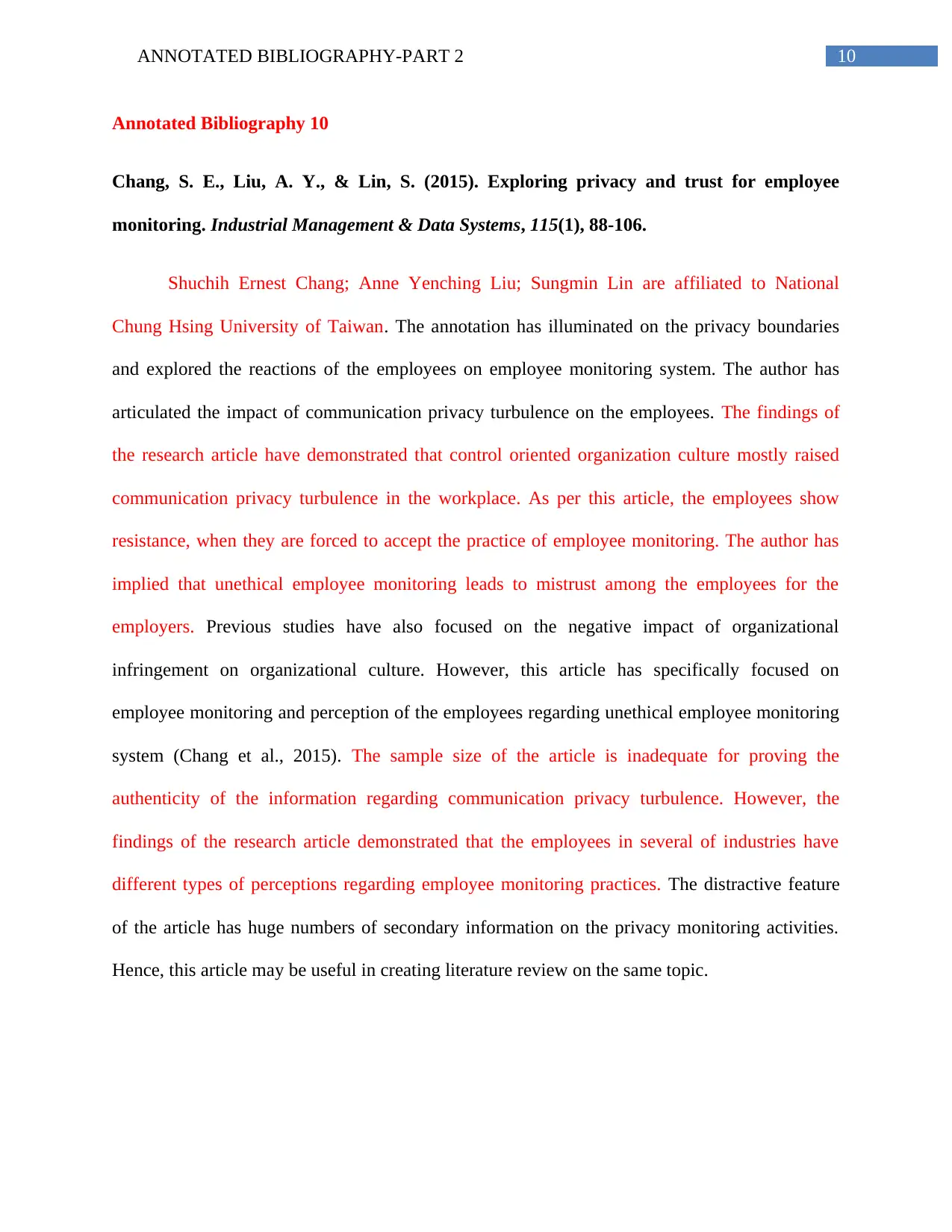
10ANNOTATED BIBLIOGRAPHY-PART 2
Annotated Bibliography 10
Chang, S. E., Liu, A. Y., & Lin, S. (2015). Exploring privacy and trust for employee
monitoring. Industrial Management & Data Systems, 115(1), 88-106.
Shuchih Ernest Chang; Anne Yenching Liu; Sungmin Lin are affiliated to National
Chung Hsing University of Taiwan. The annotation has illuminated on the privacy boundaries
and explored the reactions of the employees on employee monitoring system. The author has
articulated the impact of communication privacy turbulence on the employees. The findings of
the research article have demonstrated that control oriented organization culture mostly raised
communication privacy turbulence in the workplace. As per this article, the employees show
resistance, when they are forced to accept the practice of employee monitoring. The author has
implied that unethical employee monitoring leads to mistrust among the employees for the
employers. Previous studies have also focused on the negative impact of organizational
infringement on organizational culture. However, this article has specifically focused on
employee monitoring and perception of the employees regarding unethical employee monitoring
system (Chang et al., 2015). The sample size of the article is inadequate for proving the
authenticity of the information regarding communication privacy turbulence. However, the
findings of the research article demonstrated that the employees in several of industries have
different types of perceptions regarding employee monitoring practices. The distractive feature
of the article has huge numbers of secondary information on the privacy monitoring activities.
Hence, this article may be useful in creating literature review on the same topic.
Annotated Bibliography 10
Chang, S. E., Liu, A. Y., & Lin, S. (2015). Exploring privacy and trust for employee
monitoring. Industrial Management & Data Systems, 115(1), 88-106.
Shuchih Ernest Chang; Anne Yenching Liu; Sungmin Lin are affiliated to National
Chung Hsing University of Taiwan. The annotation has illuminated on the privacy boundaries
and explored the reactions of the employees on employee monitoring system. The author has
articulated the impact of communication privacy turbulence on the employees. The findings of
the research article have demonstrated that control oriented organization culture mostly raised
communication privacy turbulence in the workplace. As per this article, the employees show
resistance, when they are forced to accept the practice of employee monitoring. The author has
implied that unethical employee monitoring leads to mistrust among the employees for the
employers. Previous studies have also focused on the negative impact of organizational
infringement on organizational culture. However, this article has specifically focused on
employee monitoring and perception of the employees regarding unethical employee monitoring
system (Chang et al., 2015). The sample size of the article is inadequate for proving the
authenticity of the information regarding communication privacy turbulence. However, the
findings of the research article demonstrated that the employees in several of industries have
different types of perceptions regarding employee monitoring practices. The distractive feature
of the article has huge numbers of secondary information on the privacy monitoring activities.
Hence, this article may be useful in creating literature review on the same topic.
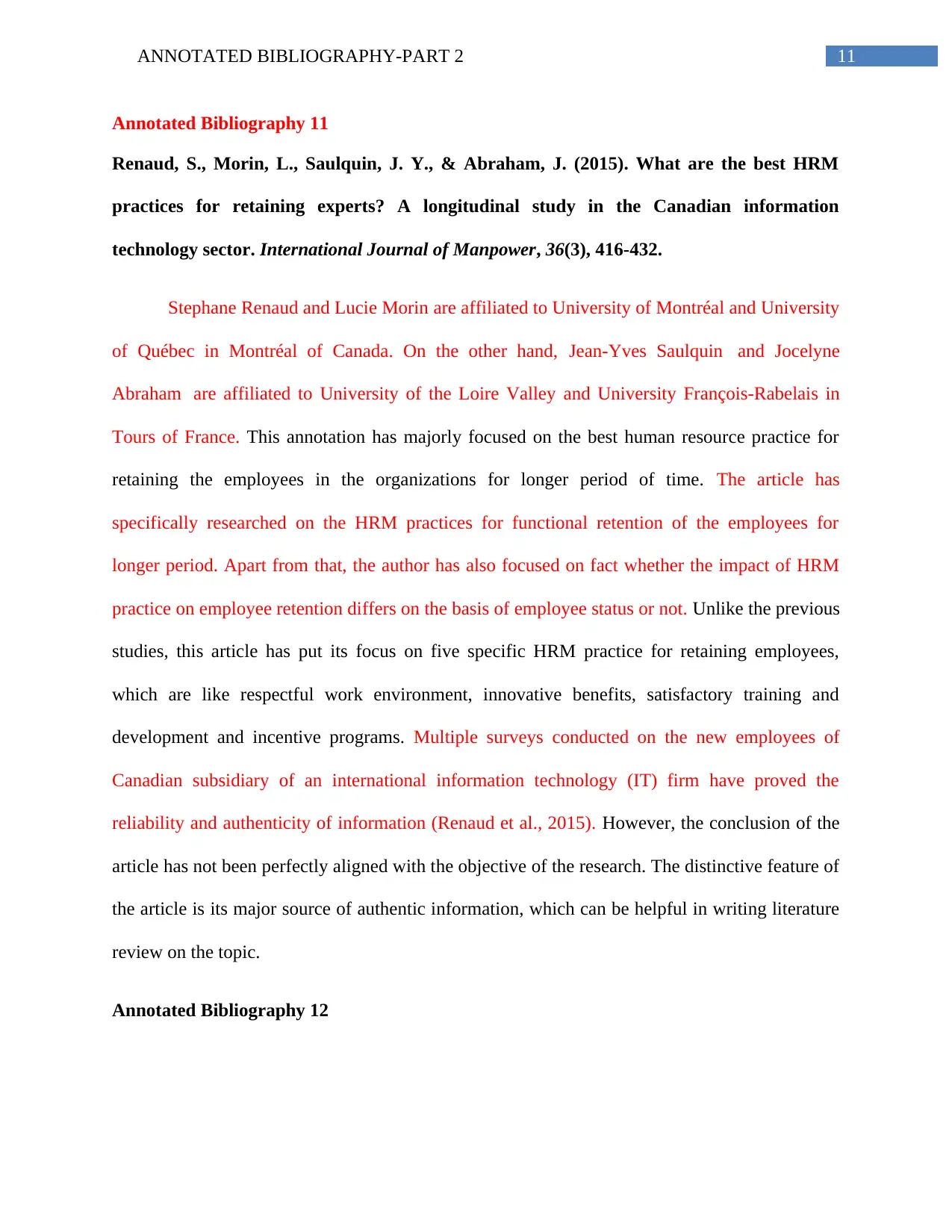
11ANNOTATED BIBLIOGRAPHY-PART 2
Annotated Bibliography 11
Renaud, S., Morin, L., Saulquin, J. Y., & Abraham, J. (2015). What are the best HRM
practices for retaining experts? A longitudinal study in the Canadian information
technology sector. International Journal of Manpower, 36(3), 416-432.
Stephane Renaud and Lucie Morin are affiliated to University of Montréal and University
of Québec in Montréal of Canada. On the other hand, Jean-Yves Saulquin and Jocelyne
Abraham are affiliated to University of the Loire Valley and University François-Rabelais in
Tours of France. This annotation has majorly focused on the best human resource practice for
retaining the employees in the organizations for longer period of time. The article has
specifically researched on the HRM practices for functional retention of the employees for
longer period. Apart from that, the author has also focused on fact whether the impact of HRM
practice on employee retention differs on the basis of employee status or not. Unlike the previous
studies, this article has put its focus on five specific HRM practice for retaining employees,
which are like respectful work environment, innovative benefits, satisfactory training and
development and incentive programs. Multiple surveys conducted on the new employees of
Canadian subsidiary of an international information technology (IT) firm have proved the
reliability and authenticity of information (Renaud et al., 2015). However, the conclusion of the
article has not been perfectly aligned with the objective of the research. The distinctive feature of
the article is its major source of authentic information, which can be helpful in writing literature
review on the topic.
Annotated Bibliography 12
Annotated Bibliography 11
Renaud, S., Morin, L., Saulquin, J. Y., & Abraham, J. (2015). What are the best HRM
practices for retaining experts? A longitudinal study in the Canadian information
technology sector. International Journal of Manpower, 36(3), 416-432.
Stephane Renaud and Lucie Morin are affiliated to University of Montréal and University
of Québec in Montréal of Canada. On the other hand, Jean-Yves Saulquin and Jocelyne
Abraham are affiliated to University of the Loire Valley and University François-Rabelais in
Tours of France. This annotation has majorly focused on the best human resource practice for
retaining the employees in the organizations for longer period of time. The article has
specifically researched on the HRM practices for functional retention of the employees for
longer period. Apart from that, the author has also focused on fact whether the impact of HRM
practice on employee retention differs on the basis of employee status or not. Unlike the previous
studies, this article has put its focus on five specific HRM practice for retaining employees,
which are like respectful work environment, innovative benefits, satisfactory training and
development and incentive programs. Multiple surveys conducted on the new employees of
Canadian subsidiary of an international information technology (IT) firm have proved the
reliability and authenticity of information (Renaud et al., 2015). However, the conclusion of the
article has not been perfectly aligned with the objective of the research. The distinctive feature of
the article is its major source of authentic information, which can be helpful in writing literature
review on the topic.
Annotated Bibliography 12
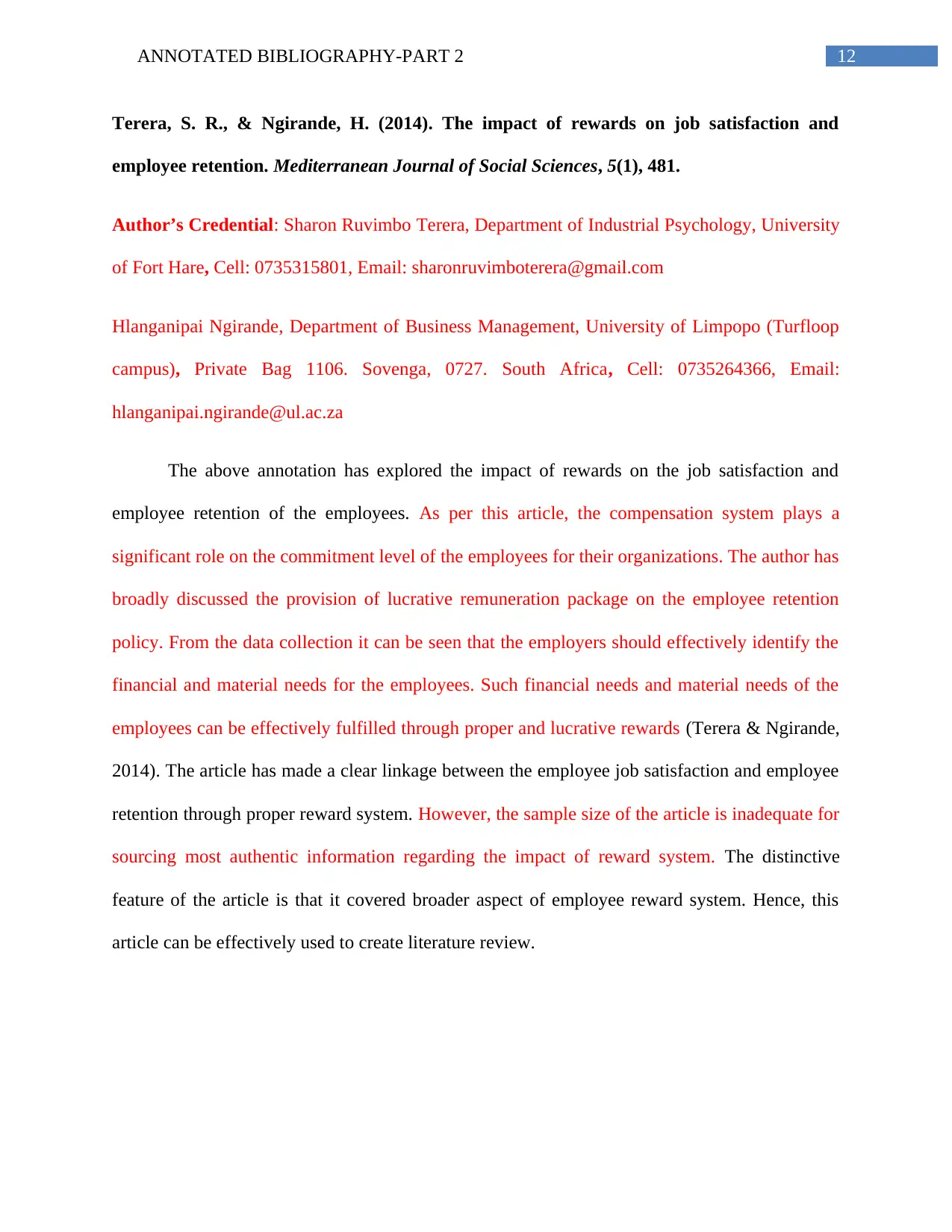
12ANNOTATED BIBLIOGRAPHY-PART 2
Terera, S. R., & Ngirande, H. (2014). The impact of rewards on job satisfaction and
employee retention. Mediterranean Journal of Social Sciences, 5(1), 481.
Author’s Credential: Sharon Ruvimbo Terera, Department of Industrial Psychology, University
of Fort Hare, Cell: 0735315801, Email: sharonruvimboterera@gmail.com
Hlanganipai Ngirande, Department of Business Management, University of Limpopo (Turfloop
campus), Private Bag 1106. Sovenga, 0727. South Africa, Cell: 0735264366, Email:
hlanganipai.ngirande@ul.ac.za
The above annotation has explored the impact of rewards on the job satisfaction and
employee retention of the employees. As per this article, the compensation system plays a
significant role on the commitment level of the employees for their organizations. The author has
broadly discussed the provision of lucrative remuneration package on the employee retention
policy. From the data collection it can be seen that the employers should effectively identify the
financial and material needs for the employees. Such financial needs and material needs of the
employees can be effectively fulfilled through proper and lucrative rewards (Terera & Ngirande,
2014). The article has made a clear linkage between the employee job satisfaction and employee
retention through proper reward system. However, the sample size of the article is inadequate for
sourcing most authentic information regarding the impact of reward system. The distinctive
feature of the article is that it covered broader aspect of employee reward system. Hence, this
article can be effectively used to create literature review.
Terera, S. R., & Ngirande, H. (2014). The impact of rewards on job satisfaction and
employee retention. Mediterranean Journal of Social Sciences, 5(1), 481.
Author’s Credential: Sharon Ruvimbo Terera, Department of Industrial Psychology, University
of Fort Hare, Cell: 0735315801, Email: sharonruvimboterera@gmail.com
Hlanganipai Ngirande, Department of Business Management, University of Limpopo (Turfloop
campus), Private Bag 1106. Sovenga, 0727. South Africa, Cell: 0735264366, Email:
hlanganipai.ngirande@ul.ac.za
The above annotation has explored the impact of rewards on the job satisfaction and
employee retention of the employees. As per this article, the compensation system plays a
significant role on the commitment level of the employees for their organizations. The author has
broadly discussed the provision of lucrative remuneration package on the employee retention
policy. From the data collection it can be seen that the employers should effectively identify the
financial and material needs for the employees. Such financial needs and material needs of the
employees can be effectively fulfilled through proper and lucrative rewards (Terera & Ngirande,
2014). The article has made a clear linkage between the employee job satisfaction and employee
retention through proper reward system. However, the sample size of the article is inadequate for
sourcing most authentic information regarding the impact of reward system. The distinctive
feature of the article is that it covered broader aspect of employee reward system. Hence, this
article can be effectively used to create literature review.
Paraphrase This Document
Need a fresh take? Get an instant paraphrase of this document with our AI Paraphraser
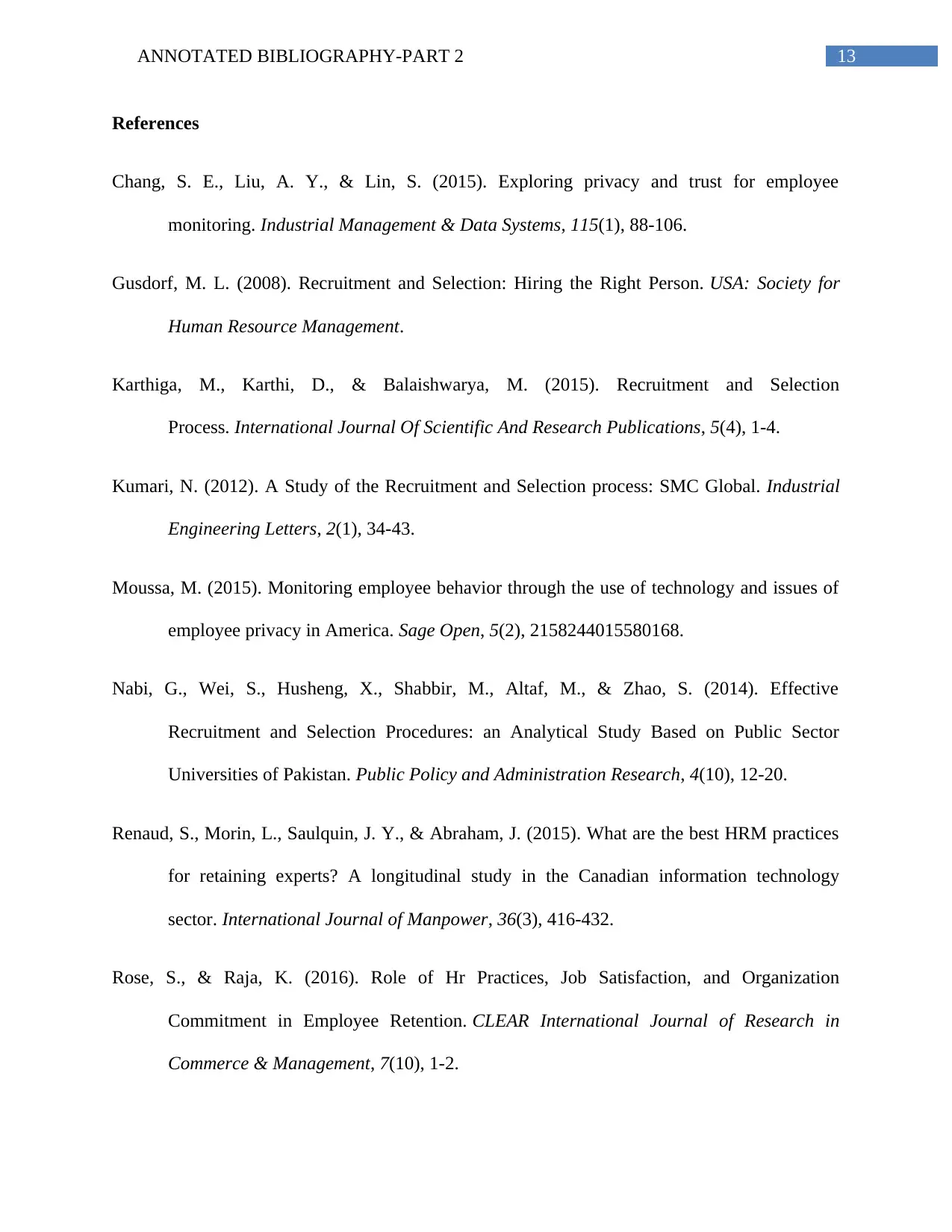
13ANNOTATED BIBLIOGRAPHY-PART 2
References
Chang, S. E., Liu, A. Y., & Lin, S. (2015). Exploring privacy and trust for employee
monitoring. Industrial Management & Data Systems, 115(1), 88-106.
Gusdorf, M. L. (2008). Recruitment and Selection: Hiring the Right Person. USA: Society for
Human Resource Management.
Karthiga, M., Karthi, D., & Balaishwarya, M. (2015). Recruitment and Selection
Process. International Journal Of Scientific And Research Publications, 5(4), 1-4.
Kumari, N. (2012). A Study of the Recruitment and Selection process: SMC Global. Industrial
Engineering Letters, 2(1), 34-43.
Moussa, M. (2015). Monitoring employee behavior through the use of technology and issues of
employee privacy in America. Sage Open, 5(2), 2158244015580168.
Nabi, G., Wei, S., Husheng, X., Shabbir, M., Altaf, M., & Zhao, S. (2014). Effective
Recruitment and Selection Procedures: an Analytical Study Based on Public Sector
Universities of Pakistan. Public Policy and Administration Research, 4(10), 12-20.
Renaud, S., Morin, L., Saulquin, J. Y., & Abraham, J. (2015). What are the best HRM practices
for retaining experts? A longitudinal study in the Canadian information technology
sector. International Journal of Manpower, 36(3), 416-432.
Rose, S., & Raja, K. (2016). Role of Hr Practices, Job Satisfaction, and Organization
Commitment in Employee Retention. CLEAR International Journal of Research in
Commerce & Management, 7(10), 1-2.
References
Chang, S. E., Liu, A. Y., & Lin, S. (2015). Exploring privacy and trust for employee
monitoring. Industrial Management & Data Systems, 115(1), 88-106.
Gusdorf, M. L. (2008). Recruitment and Selection: Hiring the Right Person. USA: Society for
Human Resource Management.
Karthiga, M., Karthi, D., & Balaishwarya, M. (2015). Recruitment and Selection
Process. International Journal Of Scientific And Research Publications, 5(4), 1-4.
Kumari, N. (2012). A Study of the Recruitment and Selection process: SMC Global. Industrial
Engineering Letters, 2(1), 34-43.
Moussa, M. (2015). Monitoring employee behavior through the use of technology and issues of
employee privacy in America. Sage Open, 5(2), 2158244015580168.
Nabi, G., Wei, S., Husheng, X., Shabbir, M., Altaf, M., & Zhao, S. (2014). Effective
Recruitment and Selection Procedures: an Analytical Study Based on Public Sector
Universities of Pakistan. Public Policy and Administration Research, 4(10), 12-20.
Renaud, S., Morin, L., Saulquin, J. Y., & Abraham, J. (2015). What are the best HRM practices
for retaining experts? A longitudinal study in the Canadian information technology
sector. International Journal of Manpower, 36(3), 416-432.
Rose, S., & Raja, K. (2016). Role of Hr Practices, Job Satisfaction, and Organization
Commitment in Employee Retention. CLEAR International Journal of Research in
Commerce & Management, 7(10), 1-2.
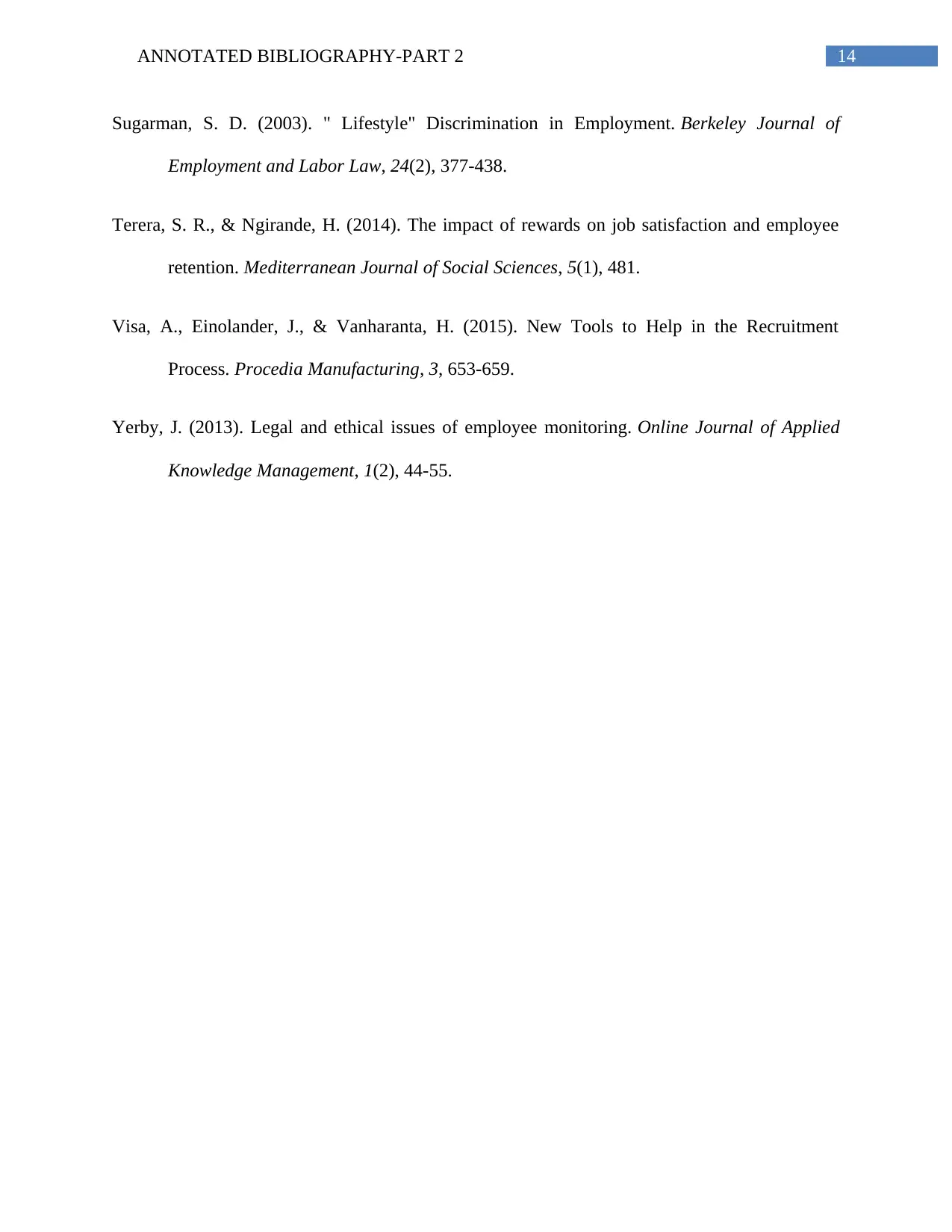
14ANNOTATED BIBLIOGRAPHY-PART 2
Sugarman, S. D. (2003). " Lifestyle" Discrimination in Employment. Berkeley Journal of
Employment and Labor Law, 24(2), 377-438.
Terera, S. R., & Ngirande, H. (2014). The impact of rewards on job satisfaction and employee
retention. Mediterranean Journal of Social Sciences, 5(1), 481.
Visa, A., Einolander, J., & Vanharanta, H. (2015). New Tools to Help in the Recruitment
Process. Procedia Manufacturing, 3, 653-659.
Yerby, J. (2013). Legal and ethical issues of employee monitoring. Online Journal of Applied
Knowledge Management, 1(2), 44-55.
Sugarman, S. D. (2003). " Lifestyle" Discrimination in Employment. Berkeley Journal of
Employment and Labor Law, 24(2), 377-438.
Terera, S. R., & Ngirande, H. (2014). The impact of rewards on job satisfaction and employee
retention. Mediterranean Journal of Social Sciences, 5(1), 481.
Visa, A., Einolander, J., & Vanharanta, H. (2015). New Tools to Help in the Recruitment
Process. Procedia Manufacturing, 3, 653-659.
Yerby, J. (2013). Legal and ethical issues of employee monitoring. Online Journal of Applied
Knowledge Management, 1(2), 44-55.
1 out of 15
Related Documents
Your All-in-One AI-Powered Toolkit for Academic Success.
+13062052269
info@desklib.com
Available 24*7 on WhatsApp / Email
![[object Object]](/_next/static/media/star-bottom.7253800d.svg)
Unlock your academic potential
© 2024 | Zucol Services PVT LTD | All rights reserved.
